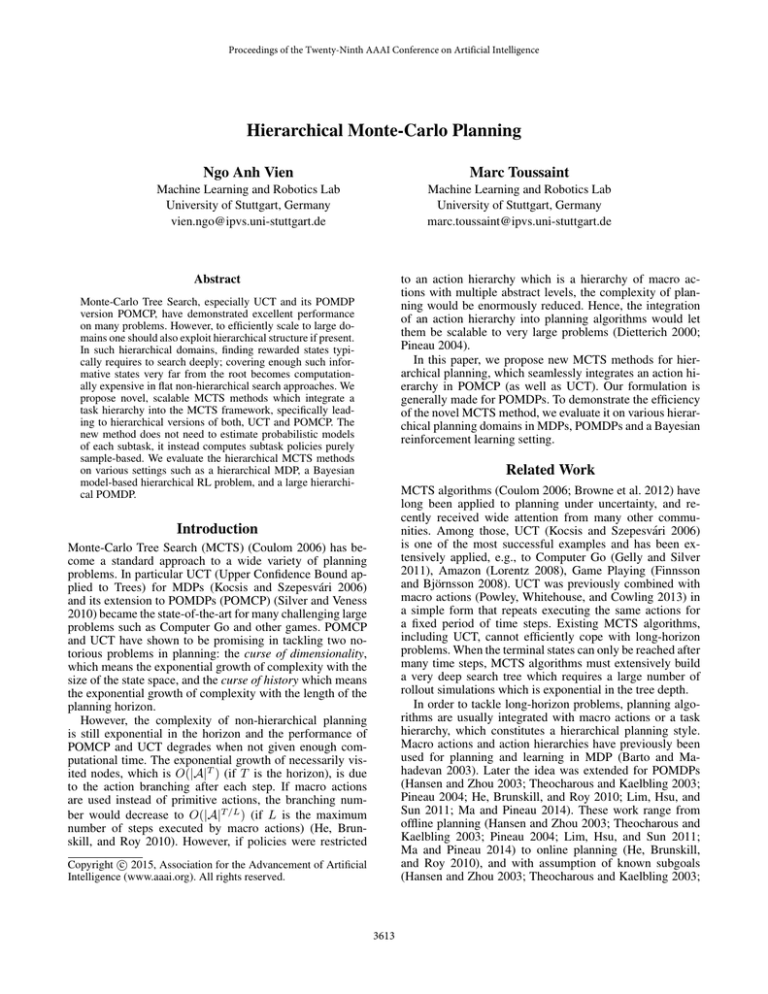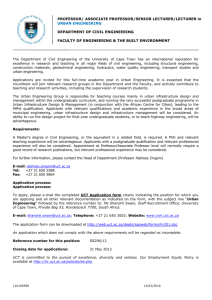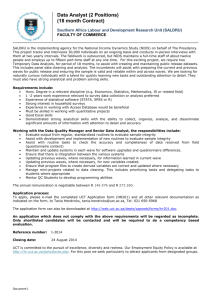
Proceedings of the Twenty-Ninth AAAI Conference on Artificial Intelligence
Hierarchical Monte-Carlo Planning
Ngo Anh Vien
Marc Toussaint
Machine Learning and Robotics Lab
University of Stuttgart, Germany
vien.ngo@ipvs.uni-stuttgart.de
Machine Learning and Robotics Lab
University of Stuttgart, Germany
marc.toussaint@ipvs.uni-stuttgart.de
Abstract
to an action hierarchy which is a hierarchy of macro actions with multiple abstract levels, the complexity of planning would be enormously reduced. Hence, the integration
of an action hierarchy into planning algorithms would let
them be scalable to very large problems (Dietterich 2000;
Pineau 2004).
In this paper, we propose new MCTS methods for hierarchical planning, which seamlessly integrates an action hierarchy in POMCP (as well as UCT). Our formulation is
generally made for POMDPs. To demonstrate the efficiency
of the novel MCTS method, we evaluate it on various hierarchical planning domains in MDPs, POMDPs and a Bayesian
reinforcement learning setting.
Monte-Carlo Tree Search, especially UCT and its POMDP
version POMCP, have demonstrated excellent performance
on many problems. However, to efficiently scale to large domains one should also exploit hierarchical structure if present.
In such hierarchical domains, finding rewarded states typically requires to search deeply; covering enough such informative states very far from the root becomes computationally expensive in flat non-hierarchical search approaches. We
propose novel, scalable MCTS methods which integrate a
task hierarchy into the MCTS framework, specifically leading to hierarchical versions of both, UCT and POMCP. The
new method does not need to estimate probabilistic models
of each subtask, it instead computes subtask policies purely
sample-based. We evaluate the hierarchical MCTS methods
on various settings such as a hierarchical MDP, a Bayesian
model-based hierarchical RL problem, and a large hierarchical POMDP.
Related Work
MCTS algorithms (Coulom 2006; Browne et al. 2012) have
long been applied to planning under uncertainty, and recently received wide attention from many other communities. Among those, UCT (Kocsis and Szepesvári 2006)
is one of the most successful examples and has been extensively applied, e.g., to Computer Go (Gelly and Silver
2011), Amazon (Lorentz 2008), Game Playing (Finnsson
and Björnsson 2008). UCT was previously combined with
macro actions (Powley, Whitehouse, and Cowling 2013) in
a simple form that repeats executing the same actions for
a fixed period of time steps. Existing MCTS algorithms,
including UCT, cannot efficiently cope with long-horizon
problems. When the terminal states can only be reached after
many time steps, MCTS algorithms must extensively build
a very deep search tree which requires a large number of
rollout simulations which is exponential in the tree depth.
In order to tackle long-horizon problems, planning algorithms are usually integrated with macro actions or a task
hierarchy, which constitutes a hierarchical planning style.
Macro actions and action hierarchies have previously been
used for planning and learning in MDP (Barto and Mahadevan 2003). Later the idea was extended for POMDPs
(Hansen and Zhou 2003; Theocharous and Kaelbling 2003;
Pineau 2004; He, Brunskill, and Roy 2010; Lim, Hsu, and
Sun 2011; Ma and Pineau 2014). These work range from
offline planning (Hansen and Zhou 2003; Theocharous and
Kaelbling 2003; Pineau 2004; Lim, Hsu, and Sun 2011;
Ma and Pineau 2014) to online planning (He, Brunskill,
and Roy 2010), and with assumption of known subgoals
(Hansen and Zhou 2003; Theocharous and Kaelbling 2003;
Introduction
Monte-Carlo Tree Search (MCTS) (Coulom 2006) has become a standard approach to a wide variety of planning
problems. In particular UCT (Upper Confidence Bound applied to Trees) for MDPs (Kocsis and Szepesvári 2006)
and its extension to POMDPs (POMCP) (Silver and Veness
2010) became the state-of-the-art for many challenging large
problems such as Computer Go and other games. POMCP
and UCT have shown to be promising in tackling two notorious problems in planning: the curse of dimensionality,
which means the exponential growth of complexity with the
size of the state space, and the curse of history which means
the exponential growth of complexity with the length of the
planning horizon.
However, the complexity of non-hierarchical planning
is still exponential in the horizon and the performance of
POMCP and UCT degrades when not given enough computational time. The exponential growth of necessarily visited nodes, which is O(|A|T ) (if T is the horizon), is due
to the action branching after each step. If macro actions
are used instead of primitive actions, the branching number would decrease to O(|A|T /L ) (if L is the maximum
number of steps executed by macro actions) (He, Brunskill, and Roy 2010). However, if policies were restricted
c 2015, Association for the Advancement of Artificial
Copyright ⃝
Intelligence (www.aaai.org). All rights reserved.
3613
Pineau 2004; Lim, Hsu, and Sun 2011) to subgoal discovery
(He, Brunskill, and Roy 2010; Ma and Pineau 2014). The
work of (Pineau 2004; Lim, Hsu, and Sun 2011) assumed
macro policies are partially defined in terms of the respective subgoals. The work of (Hansen and Zhou 2003) optimized finite state controllers, and (Toussaint, Charlin, and
Poupart 2008) used an expectation maximization (EM) algorithm to learn both hierarchical controller and macro policies. On the other hand, the approaches in (Pineau 2004)
and Theocharous and Kaelbling (Theocharous and Kaelbling 2003) went to approximate all subtasks’ models to then
use a standard POMDP solver to find the policies. It is clear
that these approximation approaches can not scale up well
for large problems.
The work (Bai, Wu, and Chen 2012) also extends MAXQ
to online hierarchical planning, however they need to estimate the model (transition Pr(s′ , t|s, a)) of macro actions
in order to evaluate completion functions. To the best of
our knowledge, our paper is the first to propose and demonstrate a purely sample-based MCTS extension for hierarchical planning.
where a new term C π (i, s, πi (s)) is called the completion
function, which is the expected reward received when continuing to follow the policy π until task i terminates. This
term is given as
!
C π (i, s, a) = s′ ,k γ k pπi (s′ , k|s, a)V π (i, s′ )
(3)
where pπi (s′ , k|s, a) is the joint probability distribution
which defines dynamics of subtask i.
As a consequence, we can recursively decompose the
value function at root node V π (0, s) until the value functions of primitive actions appear, at which V (i, s) = R(i, s)
for i are primitive actions. Existing methods for hierarchical
planning in MDPs estimate the model of compound actions
pπi (s′ , k|s, a) as PolCA method (Pineau 2004). In hierarchical RL setting, the MAXQ algorithm was proposed by Dietterich (Dietterich 2000).
Partially Observable Semi-MDP
Partially observable semi-MDPs (POSMDPs) (White 1976)
generalize POMDPs by integrating macro actions. A POSMDP is defined as a 6-tuple {·, ·, A, P, R}, where the state
and observation spaces are as in a POMDP; A is an action space which could consist of either primitive actions
or macro actions; P is a joint probability distribution over
a next state, the number of time steps and the observation
if in state s an action a is executed, P(s, a, s′ , o, k) =
P r(s′ , k, o|s, a), where o ∈ Ok is a sequence of primtive
observations ot until time k; R is a reward function R(s, a).
The belief update operator is b′ = τ (b, a, o), where
!∞
!
(4)
b′ (s′ ) ∝ t=1 γ t−1 s∈S Pr(s′ , o, t|s, a)b(s) .
Background
POMDP
POMDPs are a generalization of MDPs where states are
partially observable. A POMDP is defined as a tuple
{S, A, O, T , Z, R, b0 }; where S is an unobservable state
space; O is an observation space; A is an action space; T
defines a state transition function, T (s, a, s′ ) = Pr(s′ |s, a);
Z is an observation function, Z(s′ , a, o) = Pr(o|s′ , a); b0
is an initial belief which represents a probability distribution
over states b0 (s) = Pr(s0 = s); and R is a reward function,
R(s, a, s′ ). A policy π : B !→ A is defined as a mapping
from the belief space to the action space. We denote the belief update operator as bt+1 = τ (bt , a, o).
Monte-Carlo Tree Search
Upper Confidence Bounds (UCB) applied to Trees (UCT)
(Kocsis and Szepesvári 2006), a standard instance of MCTS
algorithms, is a tree search algorithm for planning in MDPs
which uses UCB1 (Auer, Cesa-Bianchi, and Fischer 2002)
as the tree policy. Later, it was extended for planning in a
POMDP, which is called Partially Observable Monte-Carlo
Planning (POMCP) (Silver and Veness 2010). The POMCP
method extends UCT in two important ways: 1) it builds
a search tree of beliefs instead of states, e.g. using particle sets as belief representation, 2) action selection is based
on counts and value functions of beliefs instead of states.
Each node of the search tree consists of a tuple ⟨n(b), V (b)⟩,
where n(b) is the number of times that belief b has been visited; and V (b) is the average return of simulations which
have started from belief b. When running a simulation, if a
node has all its actions selected at least once, its subsequent
actions are selected by the UCB1 policy, named tree policy,
in which it maximizes the sum of the average return and an
exploration bonus
"
$
#
a = argmaxa′ Q(b, a′ ) + c log n(b)/n(b, a′ )
(5)
MAXQ
The MAXQ framework was first introduced in the MDP
setting and assumes that we are given an action hierarchy H = {a0 , a1 , . . . , an }, which is a tree of primitive actions (at leaf nodes) and compound actions (internal nodes).
MAXQ is an instance of semi-MDP formulation (SMDP).
A core concept of MAXQ is a hierarchical value decomposition. In contrast to plain MDPs, in SMDPs the transition function is defined as the joint probability distribution
p(s′ , k|s, a) over the next state and the number of execution time steps when taking action a in state s. The Bellman
equations for SMDPs can be written as follow
!
V π (s) = R̄(s, π(s))+ s′ ,k γ k p(s′ , k|s, π(s))V π (s′ ) (1)
where R̄(s, π(s)) is the expected reward received when taking action π(s) at state s; πi is a policy of the task ai , and
π = π0 . When defining the reward term V π (i, s) as the expected value of following a policy π starting at state s until
the subtask i terminates we can rewrite the above Bellman
equation as
V π (i, s) = V π (πi (s), s) + C π (i, s, πi (s)) ,
where n(b, a′ ) is the total number of times that action a′ has
been selected at belief b, and c is a bias constant.
Otherwise, the actions are selected by another policy,
named rollout policy. A uniform action selection strategy is
often used for the rollout policy. Domain knowledge can be
(2)
3614
used to design a better rollout policy. When the simulation
ends only one new node is added to the search tree. This
node corresponds to the next belief of the last belief in the
tree visited during that simulation.
Hierarchical POMDPs as a Hierarchy of
POSMDPs
We first discuss how a hierarchical POMDP implies a hierarchy of POSMDPs, similar to the approach of Pineau
(Pineau 2004). The main differences are two-fold: 1) we decompose tasks until we meet primitive subtasks which cannot be further decomposed, which is similar to the original
procedure in MAXQ, instead of using an approximation of
subtasks’ models or value functions; 2) these decomposed
tasks are solved online by our proposed hierarchical MCTS
algorithm.
Given an action hierarchy as previously described, the hierarchical policy π = {π0 , · · · , πn } is defined as a tree of
subtask policies. The execution of a subtask terminates with
the observation of a terminal symbol or when exceeding a
maximum execution time. The call of a task policy leads to
calls of all its child policies. When a child node’s execution
terminates, it returns control to its immediate parent node in
the hierarchy. To optimize the subtask policies we will first
establish below that each subtask with macro actions as child
nodes implies a POSMDP. We then continue to describe how
to decompose the value functions for such a POSMDP, giving similar definitions for reward terms and completions as
in the MAXQ framework.
Figure 1: An example similar with the Taxi problem, with
four actions {a1 , a2 , P ickup, P utdown}. The macro actions are GET, PUT, NAV. Dotted lines represent rollout policy calls, solid lines are tree policy calls. The green subtree
of NAV consists of only primitive actions. The blue subtrees
of GET and PUT consist of NAV and Pickup/Putdown. The
gray subtree of Root consists of GET and PUT.
From the above decomposition we can derive an online hierarchical MCTS planning algorithm for hierarchical
POMDP problems. First, note that the reward term, which
is an immediate reward if projected on its parent task and
was previously represented by one node in the search tree
in flat MCTS for MDP/POMDP as it is primitive, should
now be represented by one sub-search tree in the parent’s
search tree. Therefore a search tree of many subtrees is used
for planning in hierarchical POMDPs. When simulating the
subtask πi (b), its corresponding sub-search tree is used to
evaluate its reward term’s rollout. The leaf nodes of a subsearch tree serve as the next nodes of its parent’s search tree.
As depicted in Figure 1, the NAV subtask is executed with
a search tree labeled by green colors, its leaves are the next
nodes of the GET search tree, etc.
In the next section we discuss in detail how to algorithmically integrate a task hierarchy in POMCP for online planning in hierarchical POMDPs.
Definition 1 We define V π (i, bt ) as the expected value when
following a policy π, starting at belief point bt at time t until
task i terminates.
The reward term is also interpreted as the projected value
function of the policy π at belief bt on subtask i (Dietterich
2000).
Definition 2 The completion term is the expected value of
completing task i after executing the subtask πi (bt ) at bt .
%
&
!
C π (i, bt , πi (bt )) =γ o,k p o, k|bt , π(bt ) ×
%
&
γ k V π i, τ (bt , πi (bt ), o, k)
where the observation o ∈ Ok is a vector of subsumed observations received between time t and t + k; the belief update τ (bt , πi (bt ), o, k) is computed by k consecutive primitive updates {τ (bt+h , at+h , ot+h )}kh=0 . Hence, we can decompose V π (i, bt ) into two terms: a reward term which is
received when taking the first action at bt , and a completion
term which is received when continuing following policy π
until termination of task i.
%
&
%
&
!
V π (i, bt ) =V π πi (bt ), bt + γ o,k p o, k|bt , π(bt ) ×
%
&
γ k V π i, τ (bt , πi (bt ), o, k)
Hierarchical Monte-Carlo Planning
In this section, we propose a generalization of both,
UCT and POMCP, for planning in hierarchical MDPs and
POMDPs. The extension needs to deal with 1) POSMDP
planning and 2) online planning with a hierarchy of POSMDPs. We call the two extended methods Hierarchical UCT
(H-UCT) and Hierarchical POMCP (H-POMCP), which
both consists of multiple levels of hierarchical H-UCT/HPOMCP searches. To unify their description, in the following we just refer to H-UCT but include the (optional) belief
set maintenance in the algorithms to handle the H-POMCP
case.
We describe the generic approach first. Each H-UCT
search is responsible for selecting the best action with respect to the subgoal of a particular macro action. The
generic algorithm consists of two interleaved stages: exe-
where πi is a macro action’s policy for node i. The completion term is a mixture of projected value functions on
subtask i at different next belief points. Therefore, this term
continues being decomposed until we have a projected value
function on a!
primitive actions which is immediately equal
to r(bt , a) = s r(s, a)bt (s).
3615
Algorithm 1 MAIN and EXECUTE procedures
Algorithm 3 ROLLOUT
MAIN(action hierarchy H)
From the ROOT node, call EXECUTE(0, b0 , H).
ROLLOUT(s, i, H, depth)
1: steps = 0
2: o = null
3: if i is primitive then
4:
(s′ , o, r, 1) ∼ Generative-Model(s, i)
5:
return s′ , o, r, 1
6: else
7:
if i terminates or γ depth < ϵ then
8:
return 0
9:
a ∼ πrollout (i, ·)
10:
[s′ , obs, r, k] = ROLLOUT(s, a, H, 0)
11:
steps = steps + k
12:
o = [o; obs]
13:
[·, obs, R, n] = ROLLOUT(s′ , i, H, depth + k)
14:
return s′ , o, r + γ k · R, steps
EXECUTE(task i, belief b, action hierarchy H)
1: o = []
2: if i is primitive then
3:
execute i, observe r, o.
4:
return o.
5: else
6:
while i not terminates do
7:
j = H-UCT(i,b,H) // Action selection
8:
obs = EXECUTE(j,b)
9:
o = [o; obs]
10:
b = τ (b, j, o). // belief update
11: return o.
Second, each sub-search tree may include other subsearch trees, if its children are still macro actions. The policy
used during a simulation depends on which sub-search tree
it is currently in.
Third, in the case of a macro action, which node of the
search tree is expanded next depends on the macro action
as usual, but also on the whole sequence of observations, as
mentioned in the previous section.
Algorithm 2 H-UCT
H-UCT(task i, belief b, hierarchy H)
1: Require: hierarchy H, belief b.
2: Initialize search tree T for task i.
3: for n = 1 : N do
4:
Sample s ∼ b.
5:
SIMULATE(s, b, i, H, T, 0)
6: return arg maxa Q(i, b, a)
Theoretical Results
cution which means executing an action and observing an
observation and reward as shown in Algorithm 1, and planning to select actions as shown in Algorithm 2.
Each macro action in the action hierarchy has a H-UCT
subroutine for action selection as in line 7 of EXECUTE in
Algorithm 1 (for each different i). The child task is executed
until termination, then returns control to its parent subroutine. If the task i consists of only primitive actions, then its
action selection subroutine is a POMCP. If the task i is a
sub-hierarchy (the task GET is a sub-hierarchy, from node
GET to NAVIGATE, pickup to primitive actions: {moveleft, move-right, move-down, move-up}) then we resort to
hierarchical UCT planning. The action selection algorithm
is shown in Algorithm 2. At the current belief, we sample
N states, then evaluate its value function by simulations.
This evaluation calls SIMULATE, shown in Algorithm 4.
The rollout policy is to hierarchically call the rollout policies of subtasks as shown in Algorithm 3.
We now explain how beliefs are maintained and the hierarchical tree is incrementally built. The search tree of HUCT is different from that of flat UCT in three ways
First, each node in the tree contains similar information
⟨N (b), V (b)⟩. However its children action nodes a are represented by sub-search trees. Whenever a simulation executes
a child action, it would run until the leaf nodes of that child’s
sub-search tree, then returns a corresponding sequence of
simulated observations and the reward term for the respective macro action. Its observation branching depends on this
observation sequence. The simulation inside the sub-search
tree is directed by its corresponding tree policy (or rollout
policy), which means that simulation is guided towards how
to accomplish the subtask of this macro action. The counts
and values of selecting these children macro actions are also
maintained ⟨N (b, a), V (b, a)⟩.
In UCT, the main source of the bias of the estimated expected return at the root node is due to the limited number
of simulations. In (Kocsis and Szepesvári 2006) (Theorem
7) it was proven that the bias reflects that the number of necessarily visited states is exponential in the horizon. In HUCT, the bias comes from two main sources: the planning
horizon—which is similar to UCT—and the propagated bias
from subtrees as its nodes.
We first study the bias for a simplified H-UCT search tree
that is built from only a two-level action hierarchy (for instance, the tree w.r.t. the GET task in the Taxi domain). In
this case the search tree has multiple UCT tree searches as
children nodes. We first provide a theorem similar to the
Theorem 7 in (Kocsis and Szepesvári 2006), which gives
the bias of the estimated expected payoff at the root.
Theorem 1 Consider H-UCT running on a tree of UCTs of
depth H, with branching factor of K. Each UCT is itself a
tree of depth T and a branching factor K0 . Then the bias of
the estimated expected payoff at the root is
%
&
O [KHc2 ln(n) + K H + H(T K0 ln(n) + K0T )]/n (6)
where c is defined in Eq.5. Please see the supplementary material for a proof. For a sketch of proof, computing a bias at a
node should incorporate the bias from its children nodes and
the bias from doing UCT planning from that node. Therefore, we can easily extend the computation of the bias to
cases of general H-UCT.
In the case of H-POMCP, the proof of the derived belief
SMDP from a POSMDP can be similarly done as Silver (Silver and Veness 2010) did, using the transformation from a
POMDP to a belief MDP.
3616
Algorithm 4 SIMULATE(state s, belief b, task i, hierarchy
H, tree T , depth h)
1:
2:
3:
4:
5:
6:
7:
8:
9:
10:
11:
12:
13:
14:
15:
16:
17:
18:
19:
20:
21:
22:
23:
24:
steps = 0 //return the number of steps executed by task i
o = null
if i is primitive then
(s′ , o, r, 1) ∼ Generative-Model(s, i) //sampling
steps = 1
return (s′ , o, r, steps)
else
if (i terminates) or (γ h < ϵ) then
return (siterminal , obsiterminal , 0, 0)
if b ̸∈ T then
for ∀a ∈ A do
T (ba) ← (Ninit (i, b, a), Qinit (i, b, a), ∅)
return ROLLOUT(s, i, H,!
h)
a = arg maxa′ Q(i, b, a′ ) + c
Figure 2: Results on MDP Taxi: (left) 5 × 5; (right) 10 × 10.
regret in each episode if the agent does not act optimally.
The discount factor γ is set to 0.99. The number of samples
is set to a wide range from 100 to 1000, which somehow
resembles limited computation time given for each online
planning step. The results show H-UCT consistently outperforms flat UCT. This is because that H-UCT search guided
by an action hierarchy apparently have higher possibility of
visiting high reward states in the very far future.
Figure 2 also includes a comparison to the result of BayesMAXQ (Cao and Ray 2012) when the subroutine MAXQ is
allowed to make use of the true transition model (for more
detail of this algorithm we refer reader to (Cao and Ray
2012)). For this we ran it long enough (at least with the same
amount of time given to UCT and H-UCT) to make sure all
value functions converged, then computed the average cumulative return of 50 subsequent episodes.
log N (i,b)
N (i,b,a′ )
[s′ , obs, r, k] = SIMULATE(s, b, a, H, T, 0) //compute a reward term
steps = steps + k
o = [o; obs]
[·, ·, R′ , n] = SIMULATE(s′ , τ (b, a, o), i, H, T, h + k)
//compute completion term
R = r + γ k · R′ //one-step look-ahead of task i
steps = steps + n
N (i, b) = N (i, b) + 1
N (i, b, a) = N (i, b, a) + 1
Q(i, b, a) = Q(i, b, a) + R−Q(i,b,a)
N (i,b,a)
return [snext , o, R, steps] // return state, subsumed observations, reward, and taken steps after taking action i
Taxi Domain: Bayesian Hierarchical RL Setting
We evaluate H-UCT in a Bayesian hierarchical RL (BHRL)
setting on two Taxi domains. This problem was recently
studied by (Cao and Ray 2012) who proposed an algorithm,
named Bayesian MAXQ, combining the MAXQ framework
and Bayesian RL. BHRL is a BRL problem with the assumption of being given an action hierarchy, so that we can vastly
reduce computational cost and speed up learning in BRL. In
the BHRL setting the agent works in an unknown environment; for learning it maintains a belief over the dynamics of
the environment. With the additional assumption of an action hierarchy the RL agent is expected to find an optimal
policy much more quickly than a flat RL agent.
As BRL naturally leads to a POMDP formulation we can
apply our methods also to BHRL. The details for this are
given in our previous work (Vien, Ngo, and Ertel 2014; Vien
et al. 2014).
We
comTable 1: Total time in 5 × 5 Taxi.
pare H-UCT to
Algorithms
Time (s)
the
method
H-UCT
579.72 ± 11.565
of
(Guez,
UCT
635.551 ± 21.418
Silver,
and
Bayesian MAXQ
46.697 ± 5.668
Dayan
2012;
MAXQ
0.166 ± 0.002
Vien and Ertel 2012), which are flat UCT solvers for BRL, and
to the Bayesian MAXQ method (Cao and Ray 2012),
which is a Bayesian model-based method for hierarchical RL. We represent beliefs using Dirichlet distributions as in previous work (Cao and Ray 2012;
Guez, Silver, and Dayan 2012). For UCT and H-UCT we
use 1000 samples (5 × 5 map) and 2000 episodes (10 × 10
map), a discount factor of 0.995, and report a mean and its
first deviation of the average cumulative rewards of 100
episodes (5 × 5 map) and 200 episodes (10 × 10 map) from
Theorem 2 Given
a
POSMDP
{S, O, A, P, R},
and a belief SMDP {B, A, P̃, R̃} (B is the belief space)
defined as P̃(b, a, τ (b, a, o, k), k)
=
!
!
′
s∈S
s′!
∈S b(s)P(s, a, s , o, k) and reward function
R̃(b, a) = s∈S R(s, a). Then, for all policies π, the value
function of the belief SMDP is equal to the value function of
the POSMDP: Ṽ π (b) = V π (b), ∀b ∈ B.
Please see the supplementary material for a proof.
Experiments
For experiments, we extensively evaluate H-UCT on various
settings: MDP, POMDP, Bayesian RL which are all typical
examples successfully using UCT.
Taxi Domain: Hierarchical Planning in MDP
We first evaluate H-UCT on a simple MDP domain, called
5 × 5 Taxi (625 states) which was first introduced by Dietterich (Dietterich 2000). We also created a more challengingly large 10 × 10 Taxi domain (2500 states) in a way that:
Each cell in the 5 × 5 domain is divided into 4 smaller cells.
This problem still has four similarly positioned landmarks.
The reward functions are -1, -20, and 40 corresponding respectively to movement costs, wrong pickup or putdown,
and correct putdown. This new task uses the same action
hierarchy as in the original Taxi domain.
In Figure 2 we report the means and first deviations for
both domains over 10 runs of the averaged cumulative return of 50 episodes varying on the number of samples. This
measure can also be interpreted as an average of the total
3617
Figure 3: Results on BHRL Taxi: (left) 5×5; (right) 10×10.
10 runs. For Bayesian MAXQ and MAXQ we used the
same setting as in (Cao and Ray 2012).
As shown in Figure 3, Bayesian MAXQ gave much worse
average cumulative rewards compared to UCT and H-UCT,
because it used the ϵ-greedy strategy to select actions, which
have been known having infinite sample complexity. Therefore, during initial episodes it suffered from many wrong
actions of high costs, i.e. wrong Pickup and Putdown actions. Moreover, the results also show that Bayesian MAXQ
does not thoroughly exploit planning when maintaining posterior models. The way it samples from the posterior model
can be considered as doing planning, but the value functions
learnt incrementally from sampled models via the MAXQ
subroutine are not tuned after observing a real transition.
UCT and H-UCT prune the tree and do search from the next
updated belief after observing a real transition. Again, the results show that H-UCT significantly outperforms UCT given
limited computation resources. When given more resource,
UCT asymptotically performs closer to the level of H-UCT.
The performance improvement in the large 10 × 10 Taxi domain is much more dramatic, which additionally reinforces
efficiency of integrating action decomposition.
Additionally, we report the total time (in seconds) needed
to run 100 episodes on the 5 × 5 domain for each algorithm
in Table 1. The reported numbers are the mean and its first
deviation over 10 runs. As Bayesian MAXQ did not fully exploit planning, it used moderate computational time. Though
we have increased planning time to the same given amount
of H-UCT, Bayesian MAXQ failed in getting performance
improvement due to the above mentioned non-tuning issue.
H-UCT and UCT algorithms work similarly by simulating
many rollouts. However H-UCT has slightly less planning
time, as its rollouts sometimes terminate early. This is because of macro actions helping the rollouts to reach more
promising state regions. In very large domains with long
horizon reward this effect should become even more pronounced.
Figure 4: Results on POMDP Pac-Man domain.
cating whether there are walls, adjacent food, and ghosts.
This is a very large POMDP problem which has 210 observations, and about 1056 states (Silver and Veness 2010).
Therefore, planning has large complexity due to the large
observation branching factor. To allow the comparison between H-UCT and UCT we designed a basic set of macro
actions which merely depends on instant observations. The
macro action set consists of moves in one direction of goleft,go-right,go-down,go-up until observing free ways perpendicular to the current direction. That means the agent
can keep moving forward until there are turning possibilities. The termination of these macro actions are naturally
defined depending on the four observation bits corresponding to walls, in which there is bit 1 (no wall) in the perpendicular direction. We use particles to represent beliefs
and use the similar particle invigoration method as in (Silver and Veness 2010). We compare H-POMCP against flat
POMCP and PUMA (He, Brunskill, and Roy 2010). For a
fair comparison, we implemented PUMA to use the same set
of macro actions and particles without using its macro action
generation function, as it is not straightforward to generalize
such a function for large state space problems. H-POMCP
and PUMA use similar execution fashion, which executes
one primitive action then re-planning. The reported numbers
in Figure 4 are the mean and the mean’s standard deviation
of average undiscounted returns per episode over 500 runs.
H-POMCP achieves a return of approximately 291, while
flat POMCP can achieve 269 at best, PUMA got a best return of 288. The gap is more dramatic when limited planning
resource is given. Remarkably, H-POMCP with at least 512
samples can easily outperform the flat POMCP with even
214 samples.
Discussion
We have proposed a principled method to integrate a task
hierarchy into MCTS algorithms and specifically extended
UCT and POMCP, named H-UCT and H-POMCP. The new
framework for hierarchical planning aims to mitigate two
challenging problems in planning: curse of dimensionality
and curse of history. In all benchmarks we considered for
UCT and POMCP we demonstrated the efficiency of the new
framework. Though H-UCT looks for only recursively optimal policies, H-UCT can be adjusted to look for a hierarchically optimal policy if formulating parametrized pseudo
rewards of subtasks into partially observable space. In general, the technique used to extend UCT to H-UCT can be
similarly be exploited to extend other MCTS methods to become hierarchical.
Hierarchical POMDP Domain
Finally we evaluate our methods on the partially observable Pac-Man domain, named pocman, which was first introduced in (Silver and Veness 2010). The pocman agent
lives in a 17 × 19 gridworld and his task is to find and eat
all food pellets and special power pills randomly scattered.
The agent can choose four navigation actions. There are four
ghosts also roaming the environment with particular strategies. The pocman agent receives a reward: −1.0 for each
move, +10 for eating a pellet, +25 for eating a ghost, and
−100 when dying (eaten by a ghost). The agent death terminates an episode. Observations are encoded by ten bits indi-
3618
Acknowledgment
Silver, D., and Veness, J. 2010. Monte-Carlo planning in
large POMDPs. In NIPS, 2164–2172.
Theocharous, G., and Kaelbling, L. P. 2003. Approximate
planning in POMDPs with macro-actions. In NIPS.
Toussaint, M.; Charlin, L.; and Poupart, P. 2008. Hierarchical POMDP controller optimization by likelihood maximization. In UAI, 562–570.
Vien, N. A., and Ertel, W. 2012. Monte Carlo tree search
for Bayesian reinforcement learning. In 11th International
Conference on Machine Learning and Applications, ICMLA,
Boca Raton, FL, USA, December 12-15, 2012. Volume 1,
138–143.
Vien, N. A.; Ngo, H. Q.; Lee, S.; and Chung, T. 2014. Approximate planning for Bayesian hierarchical reinforcement
learning. Applied Intelligence 41(3):808–819.
Vien, N. A.; Ngo, H.; and Ertel, W. 2014. Monte Carlo
Bayesian hierarchical reinforcement learning. In International conference on Autonomous Agents and Multi-Agent
Systems, AAMAS ’14, Paris, France, May 5-9, 2014, 1551–
1552.
White, C. C. 1976. Procedures for the solution of a
finite-horizon, partially observed, semi-Markov optimization problem. Operations Research 24(2):348–358.
We would like to thank Csaba Szepesvari for constructive
comments over the very first draft. This work was supported
by the EU-ICT Project 3rdHand 610878.
References
Auer, P.; Cesa-Bianchi, N.; and Fischer, P. 2002. Finitetime analysis of the multiarmed bandit problem. Machine
Learning 47(2-3):235–256.
Bai, A.; Wu, F.; and Chen, X. 2012. Online planning for
large MDPs with MAXQ decomposition. In AAMAS, 1215–
1216.
Barto, A. G., and Mahadevan, S. 2003. Recent advances
in hierarchical reinforcement learning. Discrete Event Dynamic Systems 13(4):341–379.
Browne, C.; Powley, E. J.; Whitehouse, D.; Lucas, S. M.;
Cowling, P. I.; Rohlfshagen, P.; Tavener, S.; Perez, D.;
Samothrakis, S.; and Colton, S. 2012. A survey of Monte
Carlo tree search methods. IEEE Trans. Comput. Intellig.
and AI in Games 4(1):1–43.
Cao, F., and Ray, S. 2012. Bayesian hierarchical reinforcement learning. In Bartlett, P.; Pereira, F.; Burges, C.; Bottou,
L.; and Weinberger, K., eds., NIPS, 73–81.
Coulom, R. 2006. Efficient selectivity and backup operators
in Monte-Carlo tree search. In Computers and Games, 72–
83.
Dietterich, T. G. 2000. Hierarchical reinforcement learning with the MAXQ value function decomposition. J. Artif.
Intell. Res. (JAIR) 13:227–303.
Finnsson, H., and Björnsson, Y. 2008. Simulation-based
approach to general game playing. In AAAI, 259–264.
Gelly, S., and Silver, D. 2011. Monte-Carlo tree search and
rapid action value estimation in computer go. Artif. Intell.
175(11):1856–1875.
Guez, A.; Silver, D.; and Dayan, P. 2012. Efficient Bayesadaptive reinforcement learning using sample-based search.
In NIPS, 1034–1042.
Hansen, E. A., and Zhou, R. 2003. Synthesis of hierarchical
finite-state controllers for POMDPs. In ICAPS, 113–122.
He, R.; Brunskill, E.; and Roy, N. 2010. PUMA: Planning
under uncertainty with macro-actions. In AAAI.
Kocsis, L., and Szepesvári, C. 2006. Bandit based MonteCarlo planning. In European Conference on Machine Learning (ECML), 282–293.
Lim, Z. W.; Hsu, D.; and Sun, L. W. 2011. Monte Carlo
value iteration with macro-actions. In NIPS, 1287–1295.
Lorentz, R. J. 2008. Amazons discover Monte-Carlo. In
Computers and Games, 13–24.
Ma, H., and Pineau, J. 2014. Information gathering and
reward exploitation of subgoals for POMDPs. In ICAPS.
Pineau, J. 2004. Tractable Planning Under Uncertainty:
Exploiting Structure. Ph.D. Dissertation, Robotics Institute,
Carnegie Mellon University.
Powley, E. J.; Whitehouse, D.; and Cowling, P. I. 2013.
Monte Carlo tree search with macro-actions and heuristic route planning for the multiobjective physical travelling
salesman problem. In CIG, 1–8.
3619








